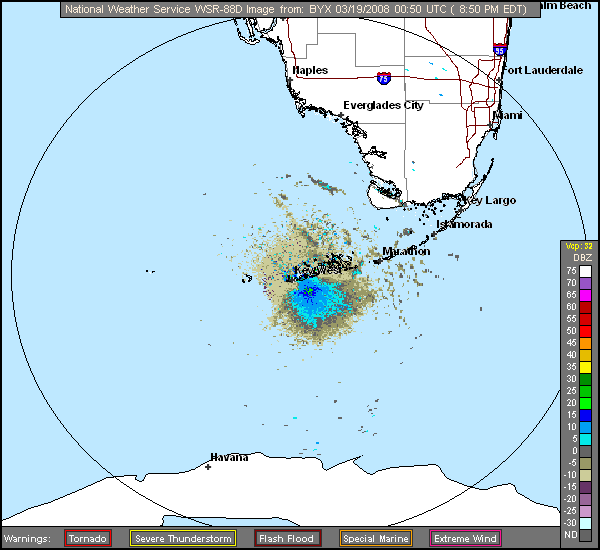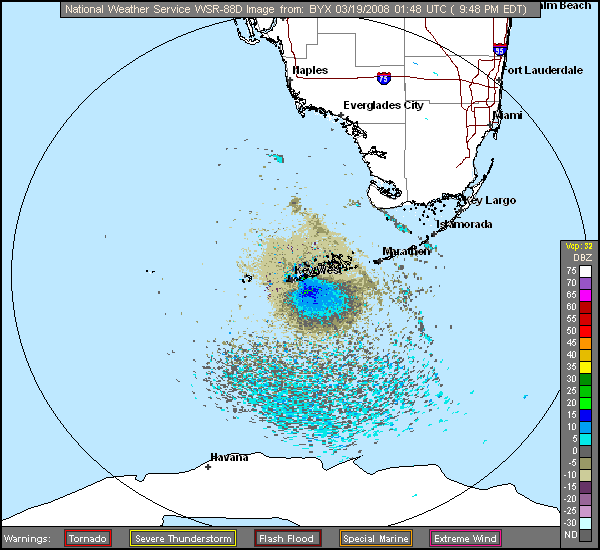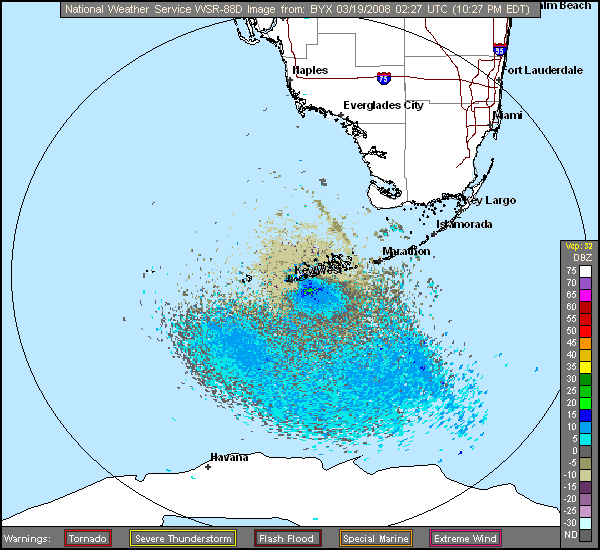Key West Migration Radar
There has not been much evidence of migration on the radar for the past three nights.Winds have been from the north, and today we have had very heavy easterly winds. Later in the day I noted that the circulation off the coast of Cuba was shifting from the southeast, towards the northwest, perhaps providing a ride across the Florida Straits for migrants piling up in Cuba.This evening I checked the Key West radar at about 10:15 PM and saw this good flight out of Cuba. The biomass of these birds is impressive!

BADBIRDZ will be back from New Zealand right after Easter, and I’m sure he will be providing us with a more comprehensive radar coverage as spring migration progresses.
This is just my humble interpretation, but it appears that a good proportion of the flocks are tending to move to the west of the Florida peninsula, over the open waters of the Gulf of Mexico, probably due to the continued strong flow from the southeast. Their rate of travel would probably bring them over the northern Gulf Coast before dawn, unless they try to fight their way back to the western coast of Florida. It would be interesting to see if there are any fall-outs.
Here is the view one hour later. The leading edge of the biomass has reached the Florida Keys.About a third are still heading out over Dry Tortugas and the open Gulf.

Unfortunately, the radar went down at 11:36 PM, but already more than 1/3 of the flock has passed over the Keys and most seem to be heading up the west coast of Florida:

Also of interest, on the evening of March 15, I captured a one-hour loop at the beginning of a similar flight, in this March 16 post. Today I found an archive of the radar that night. It should be available at this link, which requires Java, for a few more days: March 15, 2008 Key West Radar Loop, from about 9:00 PM to 1:00 AM (Be patient as it loads slowly).













March 19th, 2008 at 11:47 am Paul-The-Other on Tropical Audubon BirdBoard (link in column to left) provided me with some professional advice, quite welcome, as “My Son the Meteorologist” is still detailed to the State of Texas to work on wildfire forecasting (they have certainly been in the news the past several days). BADBIRDZ2 maintains the “Florida Migration Radar” site, which also has a link in the left panel) .
Paul said: “I work with satellite water vapor loop, and close in radar as well as NOAA. The direction of the echo returns, where they appear and the direction they take, appearing and disappearing all lead to details for interpretation. No water vapor return and no close in rain radar rule out water returns. I ignore the typical blue ground clutter return around Miami and Ft. Lauderdale. But large “returns” what ever color that move south to north with 15 minute intervals has always proven to me to be birds.
At Barbirdz2 you can (when the owner is home) actually watch the birds rise and descend. It is a “tool”..not infallible but worthy of watching once in a while.”
Bad Birdz2 is a good location for technical details: http://badbirdz2.wordpress.com/